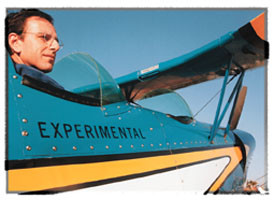Are you a journalist? Please sign up here for our press releases
Subscribe to our monthly newsletter:

Soaring above the Negev in a plane he built himself, the sky is truly the limit for Rudi Bertocchi. But the same could be said of his daily work at the lab bench, where he's contributing to cutting-edge solar energy research at the Weizmann Institute. While he downplays any connection between his flying hobby and his research, one thing's clear: Rudi Bertocchi enjoys contending with the powers of nature.
"Since I was six I've wanted to fly," says Bertocchi, a Ph.D. student in the Environmental Sciences and Energy Research Department. His interest in flying evolved quickly, from childhood gliders and gas-powered remote-control planes to a master's degree in aeronautical engineering at age 23. A private flying license followed the same year. Then the big step: his own wings. "Some people buy a car. I bought myself an airplane."
After exploring the skies above his native Sweden for a year, he took his plane for the greatest flight of his life: aliya. A test run in a 1930s Tiger Moth inspired him on his next endeavor: to build his own plane. The wings, body, and engine emerged in fits and starts over 15 years. "It takes 3,000 hours to build a plane, and how you spread those hours is up to you," he says. As Bertocchi has proved, a drill press in the basement and plenty of patience doesn't hurt either. The final product debuted in 1996 over Herzliya: a 150-horsepower two-seater, fit for a dogfight with the Red Baron himself.
But while his head is in the clouds on weekends, weekdays find Bertocchi firmly grounded in his daily research. A Ph.D. student under the supervision of Professor Jacob Karni of the Environmental Sciences and Energy Research Department, he's working to develop a new way to use solar energy on a large scale. "Solar energy is used to generate only about 0.1% of the worlds energy demands," says Karni, "If it could be produced efficiently the market would flock to it."
The current generation of solar reactors work like furnaces, using focused solar light to heat a solid matrix, which in turn heats a gas flowing through the chamber. The heated gas, under tremendous pressure, then powers a turbine to make electricity. However, if tiny carbon particles were mixed into the gaseous mixture, the gas might be heated directly, rendering the solid matrix unnecessary. His role in the research is to study the behavior of the carbon particles. The advantages to the method could include cheaper, easier-to-build reactors. Also, by simply varying the concentration of the particles in the gas, engineers could better tailor reactors for a change in conditions - say, a cloudy day at the power plant.
He sees flying not as a way to relax but as an intense experience in itself. "When you fly, you're fully consumed in the act of flying," says Bertocchi, "You don't have time to think of work." Is there another plane to be built in his future? "I've already built one," he says. "Now I want to go flying."